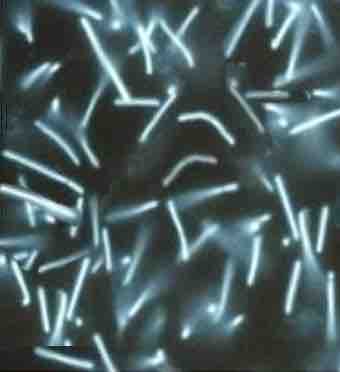A hyperthermophile is an organism that thrives in extremely hot environments, from 60 degrees C (140 degrees F) and up. Hyperthermophiles are a subset of extremophiles within the domain Archaea. An optimal temperature for the existence of hyperthermophiles is above 80°C (176°F). Some bacteria are even able to tolerate temperatures of around 100°C (212°F). Many hyperthermophiles are also able to withstand other environmental extremes like high acidity or radiation levels.
Hyperthermophiles were first discovered by Thomas D. Brock in hot springs in Yellowstone National Park, Wyoming. Since then, more than 70 species have been discovered. The most hardy hyperthermophiles yet discovered live on the superheated walls of deep-sea hydrothermal vents, requiring temperatures of at least 90°C for survival.
One extraordinary heat-tolerant hyperthermophile is the recently discovered Strain 121, an archaeon living at 121°C in the Pacific Ocean. Strain 121 has been able to double its population during 24 hours in an autoclave at 121°C (hence its name). Strain 121 survived being heated to 130°C for two hours, but was unable to reproduce until it was transferred to fresh growth medium at the relatively cooler temperature of 103°C. The current record growth temperature is 122°C for Methanopyrus kandleri ,an archaeon found in a Central Indian Ridge. Other hyperthermophile archaea include Pyrolobus fumarii, which lives at 113°C in Atlantic hydrothermal vents, and Pyrococcus furiosus, first discovered in Italy near a volcanic vent.

Methanopyrus kandleri
Methanopyrus kandleri can survive and reproduce at 122 °C.
Although no hyperthermophile has yet been discovered living at temperatures above 122°C, their existence is very possible. However, it is thought unlikely that microbes could survive at temperatures above 150°C, as the cohesion of DNA and other vital molecules begins to break down at this point.
There are a number of proposed high temperature adaptions of hyperthermophiles. Early research into hyperthermophiles speculated that their genome could be characterized by high guanine-cytosine content; however, recent studies show that there is no obvious correlation between the GC content of the genome and the optimal environmental growth temperature of the organism. The protein molecules in the hyperthermophiles exhibit hyperthermostability - that is, they can maintain structural stability (and therefore function) at high temperatures. Such proteins are homologous to their functional analogues in organisms which thrive at lower temperatures, but have evolved to exhibit optimal function at much greater temperatures. Most of the low-temperature homologues of the hyperthermostable proteins would be denatured above 60°C. Such hyperthermostable proteins are often commercially important, as chemical reactions proceed faster at high temperatures. The cell membrane of hyperthermophiles contains high levels of saturated fatty acids, which are usually arranged in a C40 monolayer to retain its shape at high temperatures.